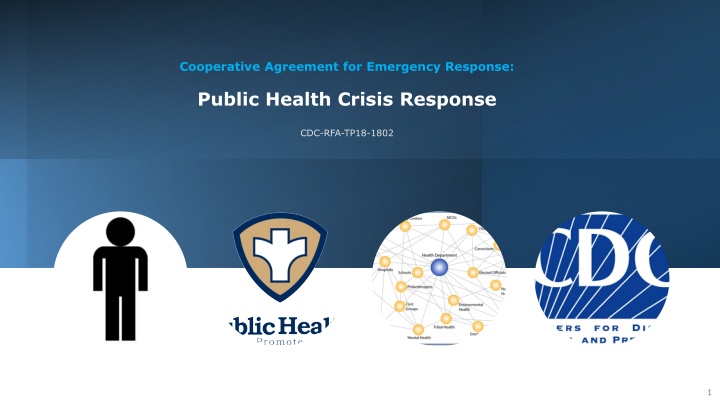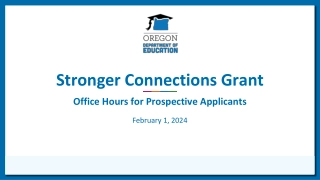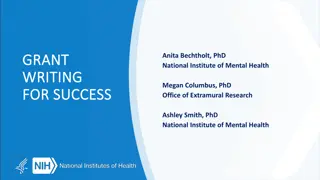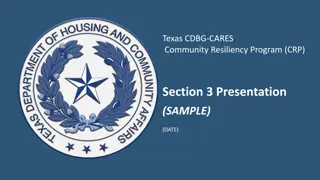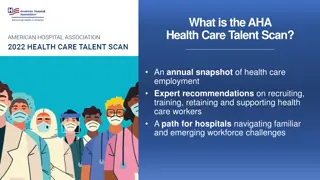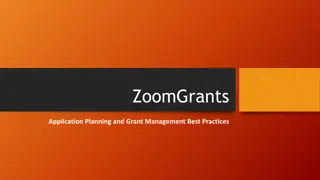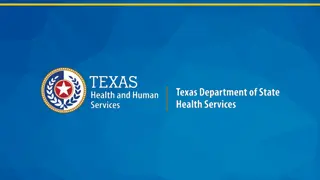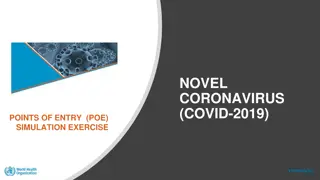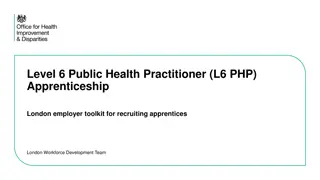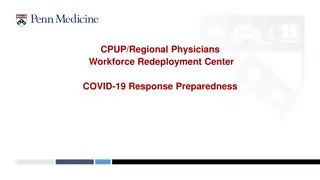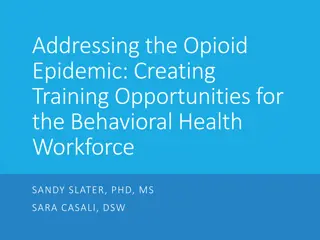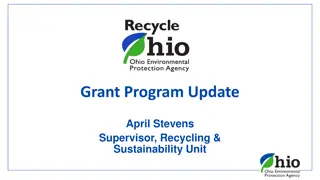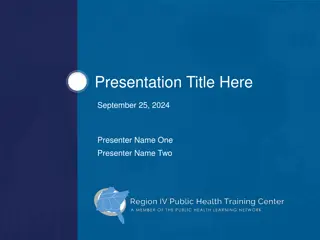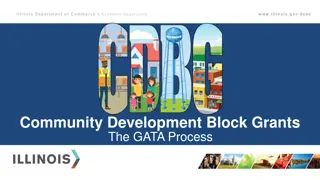Enhancing Public Health Workforce for COVID-19 Response Grant Program
This cooperative agreement aims to strengthen public health departments by expanding staff, hiring school nurses, and developing public health leaders. It includes major goals like creating a Public Health AmeriCorps and modernizing the public health workforce. The grant terms specify funding distribution and conditions for compliance with COVID-19 directives, patient care, test reporting, vaccine distribution, and data sharing. Public health agencies are expected to recruit, hire, and train personnel to support COVID-19 initiatives using CDC's Social Vulnerability Index data. Allowed personnel types include full-time staff, fellows, interns, and contractors.
Download Presentation

Please find below an Image/Link to download the presentation.
The content on the website is provided AS IS for your information and personal use only. It may not be sold, licensed, or shared on other websites without obtaining consent from the author.If you encounter any issues during the download, it is possible that the publisher has removed the file from their server.
You are allowed to download the files provided on this website for personal or commercial use, subject to the condition that they are used lawfully. All files are the property of their respective owners.
The content on the website is provided AS IS for your information and personal use only. It may not be sold, licensed, or shared on other websites without obtaining consent from the author.
E N D
Presentation Transcript
Cooperative Agreement for Emergency Response: Public Health Crisis Response CDC-RFA-TP18-1802 1
AGENDA Grant Overview Grant Administration Open Discussion 2
Part I Grant Overview 3
Expand Public Health Departments with Additional Staff to Support COVID-19 Dedicated Funding to Hire School Nurses Development of Public Health Leaders MAJOR GOALS Creation of Public Heath AmeriCorps (federal) Expand CDC Epidemic Intelligence Service (EIS) Create a new program to expand, train and modernize future public health workforce through a new grant program 4
GRANT TERMS & CONDITION SPECIFICS Amount Grant Period Nationally - $7.4B/$2B to STLT Texas (State) - $157M Texas (City of Houston) - $16M Distribution 25% School Nurse ($39M) 75% Remaining 40% to LHD/Community ($47M) 60% open ($71M) Two year period: Jul 2021 Jun 2023 (In notice: Efforts are underway, subject to availability of funds to develop solutions that allow for a more sustained workforce. Details will be provided when available.) Terms & Conditions (General related to any grant associated with COVID from Feds) 1) Comply with existing and/or future directives and guidance from HHS Secretary 2) Provide individual COVID-19 patient care regardless of external constraints 3) Assist USG in implementation and enforcement of federal orders related to Q & I 4) Comply with COVID-19 test reporting 5) Provide CDC data or access to data collected through use of these funds 6) Distribute and administer vaccine as per fed guidelines 7) Concurrence among state health official, preparedness, lab and epi programs 5
Establish, expand, train, and sustain the STLT public health workforce to support jurisdictional COVID-19 prevention, preparedness, response, and recovery initiatives, including school- based health programs. CDC expects public health agencies to use available funding to: Recruit, hire, and train personnel to address projected jurisdictional COVID-19 response needs over the performance period, including hiring personnel Use CDC s Social Vulnerability Index data and tools to inform jurisdiction COVID-19 planning, response, and hiring strategies. Funding Focus Hire personnel for roles that may range from senior leadership positions to early career or entry-level positions Types of Personnel Allowed: Permanent full-time and part-time staff (which may include converting part-time positions to full-time positions during the performance period) Temporary or term-limited staff Fellows Interns Contractors or contracted employees 6
Professional or clinical staff, including public health physicians and nurses (other than school-based staff); mental or behavioral health specialists to support workforce and community resilience; social service specialists; vaccinators; or laboratory scientists or technicians; Disease investigation staff, including epidemiologists; case investigators; contact tracers; or disease intervention specialists; Allowable Costs School nurses and school-based health services personnel, including hiring school-based nurses, converting current nurses from part-time to full-time work, increasing hours, increasing nursing salaries or otherwise supporting retention efforts; The costs, including wages and benefits, related to recruiting, hiring, and training of individuals to serve as: Program staff, including program managers; communications and policy staff; logisticians; planning and exercise specialists; program evaluators; pandemic preparedness and response coordinators to support the current pandemic response and identify lessons learned to help prepare for possible future disease outbreaks; health equity officers or teams; data managers, including informaticians, data scientists, or data entry personnel; translation services; trainers or health educators; or other community health workers; Administrative staff, including human resources personnel; fiscal or grant managers; clerical staff; staff to track and report on hiring under this cooperative agreement; or others needed to ensure rapid hiring and procurement of goods and services and other administrative services associated with successfully managing multiple federal funding streams for the COVID-19 response; and Any other positions as may be required to prevent, prepare for, and respond to COVID 19 Equipment, supplies and administrative services to support public health workforce expansion 7
Forming partnerships with academic institutions, creating student internship or fellowship opportunities, and building graduation-to-workforce pipelines and establishing partnerships with schools of public health, technical and administrative schools, and social services and social science programs; Using funds to conduct a workforce analysis to determine whether health departments were organized to maximum benefit for the COVID-19 response and how they may want to be reconstituted to prepare for future emergencies. Training and education for new and existing staff on topics such as incident management training; health equity issues and working with underserved populations; cultural competency; disease investigations; informatics or data management; or other needs identified by the jurisdiction. Allowable Activities Developing, training, and equipping response-ready strike force teams capable of deploying rapidly to meet emergent needs, including through the Emergency Management Assistance Compact. Ensuring a focus on diversity, health equity, and inclusion by delineating goals for hiring and training a diverse work force across all levels who are representative of, and have language competence for, the local communities they serve. CDC s Social Vulnerability Index should be used to inform jurisdictional activities, strategies, and hiring. Ensuring the systematic collection of information about the activities, characteristics, and outcomes of programs, including COVID-19 pandemic response efforts, to inform current program decisions, improve program effectiveness, and make decisions about future program development. Addressing community recovery and resilience needs to respond effectively to the COVID-19 pandemic and other biologic threats including vaccine-related education. 8
Progress toward meeting hiring goals including types of staff hired and the general roles they hold. Recipients must report these data for all staff, including those hired by subrecipients. Measures and Metrics Recipients should develop approximate goals and metrics regarding diversity of staff hired and equity and inclusion activities, and report on their progress against those measures. 9
Overview PH Infrastructure PH Workforce Workforce Expertise PH Americorps Modernize Focus PH Workforce Establish Expand Train Sustain Allowable Staff & Support PH positions Admin Support Partnerships Equipment Funding $157M Total $39M School $47M Local $71M 2-years Summary Future New Grant to sustain $3B CDC will work with public health community Metrics Staff and Equity #staff hired Diversity SVI 10
Part II Grant Implementation 11
SVI Underfunded (Inability to perform essential public health functions as per Texas Health and Safety Code Chapter 121) Strategic Guidelines Diversity/Social Determinants of Health/One Health Survey Responses Ability to spend
Essential Public Health Services: a) monitor the health status of individuals in the community to identify community health problems; b) diagnose and investigate community health problems and community health hazards; c) inform, educate, and empower the community with respect to health issues; d) mobilize community partnerships in identifying and solving community health problems; e) develop policies and plans that support individual and community efforts to improve health; f) enforce laws and rules that protect the public health and ensure safety in accordance with those laws and rules; g) link individuals who have a need for community and personal health services to appropriate community and private providers; h) ensure a competent workforce for the provision of essential public health services; i) research new insights and innovative solutions to community health problems; and j) evaluate the effectiveness, accessibility, and quality of personal and population-based health services in a community. Texas Health and Safety Code Chapter 121
SVI Locations Social vulnerability refers to the potential negative effects on communities caused by external stresses on human health. Such stresses include natural or human-caused disasters, or disease outbreaks. Reducing social vulnerability can decrease both human suffering and economic loss. Percentile of .075 or higher; the county is more vulnerable than 75% of all counties against which it is ranked. This includes only counties with an existing LHE. Angelina Bee Caldwell Calhoun Cameron Cherokee El Paso Hale Hidalgo Jim Wells Kleberg Navarro Potter San Patricio Terry Uvalde Webb Zapata
Survey 15
PH Workforce Crisis Co-Ag Period of Performance - July 1, 2021 - June 30, 2023 (2 yrs) Duration (working days) Task / Activities Start Date End Date Local Health Entities (LHE) Call - 2:00 - 3:00 pm LHEs & DSHS Programs - Declaration of Intent to Apply (DIA) submitted "Save the date" email invite to Stakeholders re: Kick-off meeting Kick-off meeting for Stakeholders Project and budget templates and Allocations sent out to LHE & DSHS Programs for completion - CHEPRS will host webinar to walk through the templates (as needed) DSHS SME's complete technical reviews, to include obtaining clarifications from LHEs as needed Quarterly Progress Reports (Q1) 8-Jun-21 8-Jun-21 0 8-Jun-21 18-Jun-21 22-Jun-21 11-Jun-21 18-Jun-21 22-Jun-21 3 0 0 23-Jun-21 12-Jul-21 13 13-Jul-21 3-Jan-22 20-Jul-21 7-Jan-22 6 5 Timeline 16
DISCUSSION 17
